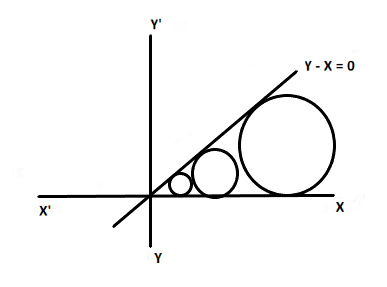
The number of circles touching the line $y-x=0$ and the $y$ axis is
A. Zero
B. One
C. Two
D. Infinite
Answer
216.3k+ views
Hint: The group of points whose separation from a fixed point has a constant value are represented by a circle. The radius of the circle, abbreviated $r$, is a constant that describes this fixed point, which is known as the circle's centre. The formula for a circle$\left(\mathrm{x}-\mathrm{x}_{1}\right)^{2}+\left(\mathrm{y}-\mathrm{y}_{1}\right)^{2}=\mathrm{r}^{2}$ whose centre is at $\left(\mathrm{x}_{1}, \mathrm{y}_{1}\right)$
Complete step by step solution:

The location of a circle in the Cartesian plane is represented by a circle equation. We can write the equation for a circle if we know the location of the circle's center and how long its radius is. All of the points on the circle's circumference are represented by the circle equation.
The line $y-x=0$ and the $y$-axis are both touched by an unlimited number of circles.
Then there are infinite number of circles
Option ‘D’ is correct
Additional Information:
The radius of a circle is the length of the straight line that connects the center to any point on its circumference. Because a circle's circumference can contain an endless number of points, a circle can have more than one radius. This indicates that a circle has an endless number of radii and that each radius is equally spaced from the circle's center. When the radius's length varies, the circle's size also changes.
Note: If the radius is r, the center's coordinates are $(h,k),$and any point on the circle is$(x, y)$, the center of the circle formula is as follows:
$(x-h)^{2}+(y-k)^{2}=r^{2}$
Complete step by step solution:

The location of a circle in the Cartesian plane is represented by a circle equation. We can write the equation for a circle if we know the location of the circle's center and how long its radius is. All of the points on the circle's circumference are represented by the circle equation.
The line $y-x=0$ and the $y$-axis are both touched by an unlimited number of circles.
Then there are infinite number of circles
Option ‘D’ is correct
Additional Information:
The radius of a circle is the length of the straight line that connects the center to any point on its circumference. Because a circle's circumference can contain an endless number of points, a circle can have more than one radius. This indicates that a circle has an endless number of radii and that each radius is equally spaced from the circle's center. When the radius's length varies, the circle's size also changes.
Note: If the radius is r, the center's coordinates are $(h,k),$and any point on the circle is$(x, y)$, the center of the circle formula is as follows:
$(x-h)^{2}+(y-k)^{2}=r^{2}$
Recently Updated Pages
JEE Atomic Structure and Chemical Bonding important Concepts and Tips

JEE Amino Acids and Peptides Important Concepts and Tips for Exam Preparation

Electricity and Magnetism Explained: Key Concepts & Applications

Chemical Properties of Hydrogen - Important Concepts for JEE Exam Preparation

JEE Energetics Important Concepts and Tips for Exam Preparation

JEE Isolation, Preparation and Properties of Non-metals Important Concepts and Tips for Exam Preparation

Trending doubts
JEE Main 2026: Application Form Open, Exam Dates, Syllabus, Eligibility & Question Papers

Derivation of Equation of Trajectory Explained for Students

Hybridisation in Chemistry – Concept, Types & Applications

Understanding the Angle of Deviation in a Prism

Understanding Collisions: Types and Examples for Students

How to Convert a Galvanometer into an Ammeter or Voltmeter

Other Pages
JEE Advanced Marks vs Ranks 2025: Understanding Category-wise Qualifying Marks and Previous Year Cut-offs

Understanding Atomic Structure for Beginners

Ideal and Non-Ideal Solutions Explained for Class 12 Chemistry

Degree of Dissociation: Meaning, Formula, Calculation & Uses

Understanding Electromagnetic Waves and Their Importance

Understanding the Electric Field of a Uniformly Charged Ring




